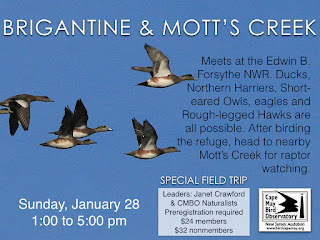As I sat at my desk at the Northwood Center, working on my recent Cuba trip report (I promise I'll finish it this week), I got a text message from friend and
Project SNOWstorm collaborator Steve Huy.
"Female [Snowy] owl crossing the bay from Henlopen right now. Headed your way."
I noted the interesting sighting, but considered staying at my desk and finishing up the report...but the time it takes for a given species to cross Delaware Bay, from Cape Henlopen to Cape May, is something of interest to us at CMBO and something we try and track during fall migration as raptors stream over the bay on their southbound pilgrimage. Armed with that self-imposed task, I grabbed my camera and headed over to the Coral Avenue dune crossover. In the time it took me to get motivated, grab the camera, and head out the door, my arrival at Coral Avenue was approximately 21 minutes after the initial text from Steve. Based on other raptor crossings, I knew that this bird could have made it across in 15-20 minutes, so whether I would see the bird actually crossing open water seemed like a long shot. I scanned over the bay and picked up a few birds on the water: a small group of 4 Greater Scaup, a few Red-throated Loons, a lone Black Scoter, a few lines of scoter way out (Black or Surf; I couldn't tell with only my binoculars). Then a large distant bird could be seen coming directly towards me and my heart skipped a beat, but quickly recovered when I realized it was only a young Herring Gull (born last summer, and quite bleached out light brown). A few more gulls later, and a nice flyby calling Bonaparte's Gull, I still lacked any sign of the great white Arctic owl.
 |
| Four Greater Scaup in the surf between Coral Ave. and St. Peter's |
 |
| A lone Bonaparte's Gull was quite vocal as it flew west past Coral Ave. |
"Just a few more minutes", I told myself, as my mind wandered to the report I had left in limbo back at the office. I walked down to the water's edge to get a better look at the scaup, and continued on to the west wondering if the bird Steve had seen might have made landfall here and settled into the dunes.
I never saw the bird come over water, and I never saw it take off from the dunes, but before I knew it I saw it flying around the corner in front of me. I still don't know where it came from, and until I see photos to compare, at this point I don't know if it's the same bird that Steve had seen heading north from Cape Henlopen, but one thing was for sure: there was a Snowy Owl on Cape May Point! I walked up the beach quickly in order to determine whether the bird had flown on or perched, and realized it was indeed posted on a nice piling, in the dunes between two of the main crossovers. I backtracked to the perimeter road and walked the pavement to Surf Avenue, where from the dune crossover I could see the bird, relaxed but aware, taking in the dune scenery. Doubling back again I headed to the Cape Avenue dune crossover which put me about equidistant, but at a better angle given the light, and enabled me to spend a few minutes observing the bird, noting its plumage, and snapping off a few photos to compare to Steve's later tonight. I did notice that the bird was not carrying a transmitter, so is not one of our currently tagged birds. Whether or not it was the "big, dark female" Steve had mentioned remains to be seen. Stay tuned for an update later this week.
 |
| The Snowy Owl from Surf Ave. dune crossing. |
 |
| The same bird from Cape Ave. dune crossing; yawning! |
Of course the real adventure is in the journey, not necessarily the destination, and while the Snowy Owl was an absolute treat, getting outside on this otherwise dreary and cold day was something I didn't expect to do, but in hindsight really needed. There were numerous American Robins littering the lawns on Cape May Point, feeding on whatever berries or worms they could procure (the ground is well thawed right now, for a little while at least), accompanied by White-throated and Song Sparrows. Having run into Mike Pasquarello at Surf Avenue, I also heard that there was quite a Bonaparte's Gull show down at Sunset Beach near the Concrete Ship. No doubt a Black-headed Gull or two is somewhere to be found for the intrepid birder, as two were present on the Delaware Bay shore on Friday.
If you're looking for some help getting out this winter, this Saturday has several great options including our Birding Cape May Point walk from 8:00 - 10:00am (meeting near the Hawkwatch platform at Cape May Point State Park; $10 - Non-members; $6 - Members; FREE - Life Members) and the
Cumberland County Winter Eagle Festival.
Click here to download our Kestrel Express which includes all of the offerings taking place this winter, of which there are many in February, which (gasp) is right around the corner!
Good Birding,
David La Puma
Director, NJ Audubon's Cape May Bird Observatory


















